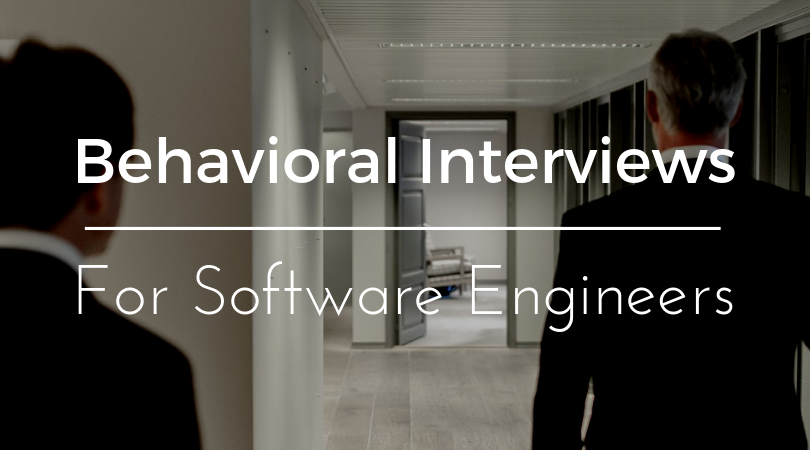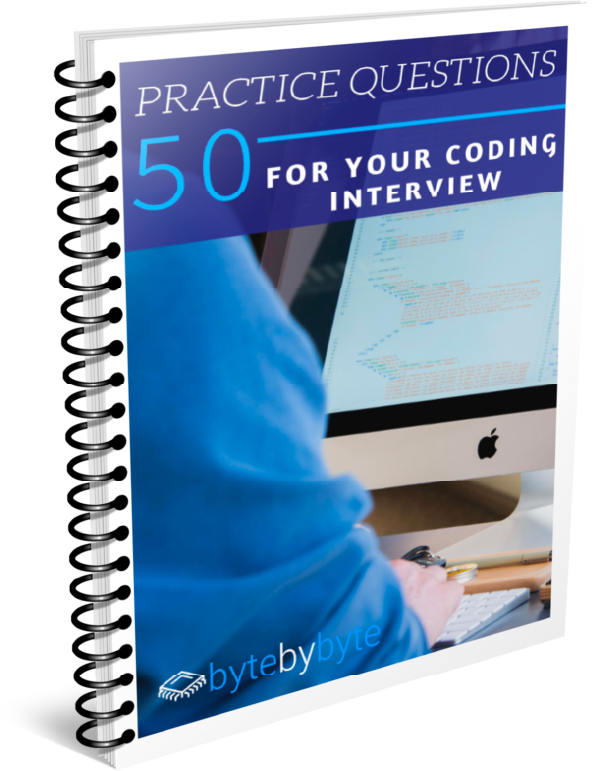
When we think of coding interviews, most of us tend to think of technical interviews—staring at a whiteboard and hoping that a solution will magically come to us (although there is a better way).
At least that’s what I think of.
Coding interviews are important, don’t get me wrong, but focusing on whiteboarding and ignoring everything else can be just as detrimental. Behavioral interviews are also super important for getting that job.
“Behavioral interviewing” is basically a catch-all for everything that you are going to do in your interview that is not coding.
This might be talking about your side projects. It may mean discussing why you’re interested in the company. Whatever it is, the best way to succeed at these interviews is to practice and then go in prepared.
Over the last three years, I’ve helped hundreds of Byte by Byte students succeed at getting jobs with all the major tech companies, from Google to Amazon to Snap and more. In this post, I’m going to break down the exact strategy you should use to prepare for your behavioral interviews—so that you’ll sound smart and get an offer even if you don’t have much prior experience.
Behavioral Interviewing Mistakes
We’re going to start here because, in some ways, avoiding these mistakes is even more important than doing everything else right. Then when you apply the principles in the rest of this guide, you’ll be in a really good place to succeed at your behavioral interviews.
These are the most common mistakes I’ve seen that you need to avoid:
Rambling
It is critical to keep your answers concise. You should never give more than a two-minute answer to any question. If your interviewer wants to dig deeper on anything that you mentioned, they will ask, otherwise you are wasting valuable time.
Take one or two sentences to set up your story, and then talk about what you did. If you have spent time preparing, you should already know how to set up, in a concise and interesting way, any of the stories that you will be telling.
Not Selling Yourself
The whole point of a behavioral interview is to sell yourself and show the interviewer why you’re the right person for the job. That means that you’re allowed to brag about your accomplishments here. Don’t be obnoxious about it, but don’t hesitate to confidently talk about what YOU accomplished.
One place where you may be underselling yourself inadvertently is when speaking about work that you did as part of a team. Yes, the fact that you worked with a team is important, but it’s also critical to specifically highlight your own accomplishments. Say “I” not “we” when talking about what you did.
Not Being Genuine
If you’ve ever heard someone say that their weakness is that they “work too hard” or anything like that, that’s a perfect example of something that will not seem genuine to your interviewer. You want to sell yourself, but picking something that would be considered a positive trait by many looks like you’re trying to cover up your real weaknesses.
Focus on telling real stories, and tie those stories back to what the company is looking for in an employee. If you do that, you don’t have to be perfect. No one expects you to be perfect. They want to see that you’re a human they want to work with.
Not Answering the Question
This one also comes down to preparation. If you don’t adequately prepare for your interview and have some stories in mind, it can be very difficult to come up with real answers to the questions. Remember that you don’t want to sound like a politician who is avoiding the question.
Especially if there are areas that you know you don’t have as strong answers for (maybe you don’t have a lot of job experience or leadership experience, for instance), take some extra time to prepare what you will talk about if you get asked questions in those areas.
If you keep these mistakes in mind as you prepare for your behavioral interviews, you’ll avoid most of the most costly missteps that people make when answering behavioral questions.
Behavioral Interview Prep
The real key to doing well in behavioral interviews is preparation.
You may think that you can just wing it with these questions, since they’re all about your own experience, but it’s critical that you go back and really analyze your experience. By following these steps, you’ll set yourself up to answer behavioral questions in an impactful way that your interviewer will really respond to.
Step 0 – Research the Company
I’m putting this as step 0, not only because we’re software engineers, but also because it comes before the real prep begins. Before you plan out specifically what you are going to say in your interview, it can be really helpful to look at the job description for the job you’re applying for, and see what soft skills they are looking for.
Most companies will say that they’re looking for someone with strong initiative, leadership skills, or other vaguely-stated soft skills. Behavioral interviews give you an amazing opportunity to show, and not tell, your interviewer about how you’re a good fit for the company.
As you go through the remaining steps, think about how you can pick stories that demonstrate those soft skills. How can you work them into your answers? For example, you can talk about how you had to coordinate lots of different team members or how you got everything done while you had a million other things to do to demonstrate your organization or leadership abilities. If you get creative, there are so many ways you can work this into your responses.
This is an advanced strategy, but it’s gold if you do it right.
Step 1 – Fill Out the Interview Preparation Grid
Gayle Laakmann McDowell has talked a lot about this grid both in Cracking the Coding Interview and several of her other books. In its simplest form, it is simply a matrix: On one axis is each of your largest projects. And on the other axis are common behavioral questions.

You can find an Excel version of the grid here.
STOP! Before you do anything else, it is critical to fill out this grid. Don’t read further in this post until you’ve downloaded and filled out the grid. It will give you much needed context for what we are going to discuss for the rest of the post.
Step 2 – Prepare Descriptions of Each Project
For every project that you’re going to be discussing, you will want to have a quick one or two sentence description of the project or situation that you are talking about. It’s really easy to ramble and give long, confusing answers here, so this is a good thing to plan ahead of time.
Write out a description for each project. Keep it short and sweet, and focus on the key points that are relevant to what you will be talking about. Once you’ve written these, practice saying them out loud so you know how they sound and can present them clearly.
Step 3 – Practice Answering Problems Using Your Grid
Before we try to memorize everything on our grid, we’re just going to practice answering some standard questions (like the ones below) with our grid in front of us. Practice formulating a one- or two-minute response to each of the questions for different combinations of projects and questions.
For example: “What was a time you had to make an unpopular decision?”
Go through each of the projects that you have listed, and try to formulate your answer according to the STAR Technique in the next section. Practice speaking out loud and thinking as you go. You want this to become easy.
Step 4 – Now, Practice Without Your Grid
If you spend adequate time on Step 3, you shouldn’t really have to spend too much time actively trying to memorize the grid itself. By practicing and applying the information (and also because it is your life), you should become very comfortable with what you have to say about each project.
However, still make sure that you do some additional practice without relying on your grid, as you don’t want it to become a crutch. Keep practicing more problems (they’re pretty similar, so you should get pretty used to what to expect and what to say).
FAQ: What if I Don’t Have Relevant Experience?
Sometimes it seems like you don’t have any relevant experience for a specific question.
Ninety-nine percent of the time this is because you’re thinking too narrowly. Consider the question “Tell me about a time when someone on your team wasn’t pulling their weight.” If you’ve never worked a job, you won’t have experience working on a corporate team. But that doesn’t mean you don’t have experience working on a team somewhere else.
Think about other stories that could be relevant. What about a sports team you were on, where someone never showed up to practice? A school project that you got stuck doing all the work on? Maybe you were the problem on a team, and you could talk about that and what you learned from the experience.
Not everything that you talk about has to be directly about past work experience. Talking about other aspects of your life (as long as you show how they’re relevant) can make you appear as a much more rounded candidate. Don’t get too siloed into that way of thinking, especially if you don’t have a lot of prior work experience.
Structuring Your Answers
Now that we know what to talk about, it’s important that we also discuss how to talk about it. The way that you structure your answers can make a big difference in how clear and engaging you are. As best as you can, you want to tell a story that is interesting to your interviewer.
The easiest way to think about structuring your answers is to use the STAR Technique.
STAR stands for Situation, Task, Action, and Result. Include each of these pieces, in that order, in your response.

Here’s a complete example of the STAR Technique first, and then we’ll break it down:
I’m going to tell you about something that happened at my summer internship. I was interning at Facebook after my junior year of college. My mentor asked me to stay late at work one night toward the end of my internship to help him with a project. We were working on building out a new message handler for X service. I didn’t know too much about Y and Z technology, but he helped me figure it out, and by 1 am we had built a working prototype. Over the next two weeks, we refined it and pushed it into production. As a result of our all-nighter, we got our code up two weeks ahead of schedule, and I made my mentor look really good. I also learned a lot of new technology, and we managed to speed up job handling by 20 percent. That’s an example of a time when I exceeded expectations.
The STAR technique is great for any interview questions asking about your experience and how you dealt with different problems. Questions like “What is your greatest weakness?” or “How did you deal with a difficult team member?” will be right at home here.
Situation (1-2 Sentences)
We already talked about the situation a bit. This is where you are going to set up the story. Give one or two sentences of background so your interviewer knows the context of what you’re going to be talking about. At bare minimum, you should mention where you were and at what point in your career this took place.
Optionally, you can also add a sentence at the beginning that summarizes more specifically what you are going to talk about. This can help make sure your interview knows what to focus on, especially for more involved stories.
Example: “I’m going to tell you about something that happened at my summer internship. I was interning at Facebook after my junior year of college.”
Task (1 Sentence)
This comes along, part and parcel, with the Situation. You want to share what you were actually trying to achieve that led you to take the action in the next step. Basically, you’re setting up the answer to their question and giving them all the relevant details so that you can demonstrate what you are talking about.
Example: “My mentor asked me to stay late at work one night toward the end of my internship to help him with a project.”
Action (3-5 Sentences)
Now we’re getting into the meat of things, where you’re actually going to describe what you did. Since we’re getting to the more relevant stuff, you can take more time to describe what you did.
Caution: Don’t go into too much technical detail here. Unless your interviewer is familiar with the technology, they’re likely not going to understand all of what you’re talking about if you go too deep. Plus, going too deep can take a lot of time.
If you’re unsure how much detail to give, err on the side of less. You can always use the following phrase: “I’m happy to describe in more detail if you’re interested.”
Example: “We were working on building out a new message handler for X service. I didn’t know too much about Y and Z technology, but he helped me figure it out, and by 1 am we had built a working prototype. Over the next two weeks we refined it and pushed it into production.”
Result (3-5 Sentences)
This is the part where you really have to bring it home and make sure that you’re connecting back to the core question. Describe the outcome, and give any specific metrics that you can.
Also do your best to tie your response back to the original question. Try and bring everything full circle, and make sure you keep this concise, like everything else.
Example: “As a result of our all-nighter, we got our code up two weeks ahead of schedule, and I made my mentor look really good. I also learned a lot of new technology, and we managed to speed up job handling by 20 percent. That’s an example of a time when I exceeded expectations.”
Common Behavioral Interviews Questions
Up until now, we’ve been talking about how to answer behavioral questions. These can be tough, and require a good amount of preparation, because we don’t know exactly what we’re going to be asked. However, there are two specific questions that you should expect to be asked in every interview.
“Tell me about yourself.”
This is the way pretty much every interview has started since the beginning of time.
True, this won’t always come up in technical interviews, since interviewers may just want to get to the meat, but you should definitely be prepared to answer this.
The core tenets apply to this question just as much as any of the other ones.
- Keep it concise and don’t ramble.
- Don’t go into too much technical detail unless they specifically ask you to.
- Keep it to two minutes or less.
- Sell yourself!
Laakmann McDowell recommends the following basic template, which gives you a very good starting point:
“I am a _____ at _____. In college I studied _____ at _____. Then I worked for _____ where I did _____. Then I worked for _____ where I did _____. In my current role, I’ve accomplished _____. In my free time, I enjoy _____.”
Obviously you’ll want to tweak this a little to make it work well for you, but this is a good place to start. For each job, focus on two or three of your main accomplishments AT MOST, and give just some high level technical detail. They can always ask you to expand further if they want more information.
Also, you don’t have to share what you do in your free time, but it can be a nice way to humanize yourself. It doesn’t really matter what you share, but do make sure to consider how what you do reflects on you.
“Do you have any questions for me?”
This is another one that you can really easily prepare in advance. If you have specific questions, this is a good opportunity to learn a bit more about the company.
One of the important things to think about here is the fact that even though you’re asking the questions, it is still part of the interview. Your interviewer will be evaluating you based on the sorts of questions you ask. Therefore, make sure you have good questions…and don’t ask about things like vacation days, since it’s not really a good first impression.
Here are some questions to get you started. I love opinion questions because you get interesting answers and can ask everyone the same question. Don’t be afraid to ask about the negatives too:
- “Can you share more about the day-to-day responsibilities of this position? What’s a typical day like?”
- “What are your favorite and least favorite parts of the job?”
- “Why did you decide to join Company X?”
- “Can you tell me about the opportunities for career advancement at Company X?”
Here are a lot more possible questions you can ask:
Other Common Behavioral Interview Questions
While there are lots of different variants of behavioral questions that you could be asked during your interview, most of them are pretty similar. With your grid completed, it should be relatively easy for you to come up with decent answers on the spot even if you haven’t seen the exact question in the past.
Here are some sample problems that you can practice:
- Tell me about a time when you faced adversity.
- What is your greatest weakness?
- Tell me about a project that didn’t go according to plan.
- What do you find most exciting about your current job? What gets you up in the morning?
- What is something new that you’ve learned recently?
- Tell me about a time when you had too much to do and not enough time.
- Describe a situation where someone on your team wasn’t pulling their weight. How did you handle this?
- Tell me about the biggest mistake that you ever made at your job.
I’ve linked to several lists of additional questions below.
Additional Resources
Here are a few resources that you’ll find helpful if you want to go deeper on any of this stuff.
- Cracking the Soft Skills
- 30 Behavioral Questions You Should Be Ready To Answer
- Behavioral Interview Questions (Categorized)
- The STAR Technique
And that’s it! That wasn’t so bad, right?
The most important thing with behavioral interviewing is simply to prepare.
Unlike technical interviews, the scope of questions you could be asked is fairly limited, so behavioral interviews really come down to taking the time to refresh your memory on the specifics of your past experience.
With a little prep, you’ll do great!
This post originally appeared on SimpleProgrammer.com.



